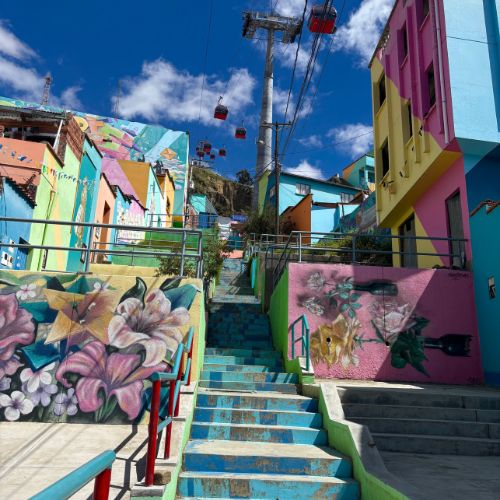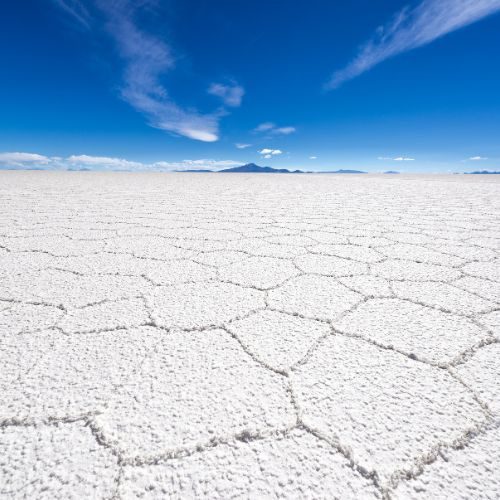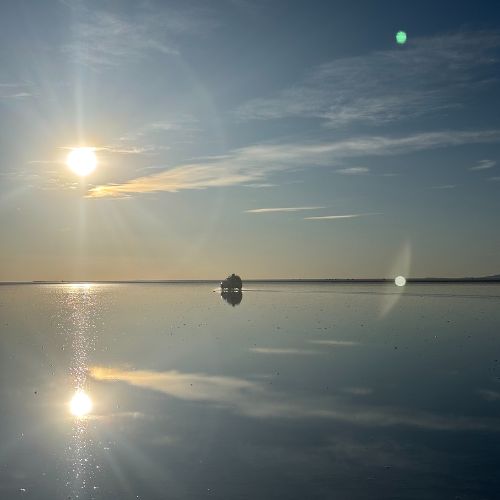The Salar de Uyuni is the world’s largest and highest continuous salt desert, with an area of over 10,000 km². It is located in southwestern Bolivia, in the department of Potosí, at about 3,650 meters above sea level. Formed by the evaporation of ancient lakes, it contains reserves of salt and lithium.
This endless white and flat landscape offers stunning views and unique optical effects, especially during the rainy season (January–March), when it turns into a giant natural mirror reflecting the sky. In the dry season (April–December), the ground is covered with hexagonal patterns of crystallized salt. These are transition months, and while they may feature a combination of landscapes, they don’t guarantee the mirror effect or a fully dry surface. They are ideal if you're looking for fewer tourists and milder weather.
The recommended number of days to visit the Salar de Uyuni depends on the type of experience you are looking for. It's important to wear proper clothing for the cold, as temperatures can drop below 0 °C at night, especially on multi-day tours. It is recommended to dress in layers: a thermal base layer, a warm middle layer, and a waterproof or windbreaker jacket. Don't forget gloves, a scarf, a hat, and sturdy shoes for walking on salt, dirt, and water terrain. Sunglasses are essential due to the intense sun at high altitude and the reflection on the white surface of the salt flat.
The Salar de Uyuni is located at about 3,650 meters above sea level, so some travelers may experience altitude sickness or “soroche.” The most common symptoms are headaches, dizziness, nausea, fatigue, and shortness of breath.
The Salar de Uyuni is located in the Altiplano, in southern Bolivia, in the department of Potosí, in Daniel Campos province, and borders Chile to the west. Uyuni is a Bolivian city from which tours to the salt flat depart.

Visiting the Salar de Uyuni in Bolivia is an enjoyable experience at any time of the year, but the type of landscape you’ll see depends on the season. There are two main seasons that offer different experiences: the rainy season and the dry season.
During the months of January to March, rains turn the surface of the salt flat into a natural mirror. A thin layer of water covers the salt desert, reflecting the sky, clouds, and sunsets with almost surreal perfection. This natural phenomenon is one of the most sought-after by travelers and photographers from around the world.
The downside of visiting during this season is that some areas may become inaccessible due to flooding, some attractions may close like Incahuasi Island, and the terrain can become more slippery and harder to navigate.
During the Andean winter, the salt flat appears as a white, firm desert cracked in natural hexagonal patterns. The weather is dry and the skies are completely clear, allowing for deep exploration of the salt flat in 4x4 vehicles and visits to iconic places like Incahuasi Island, the Salt Hotel, the Train Cemetery, and more.
The advantage of visiting during this season is that you can travel across the entire salt flat without restrictions. Tours reach more destinations in and around the salt flat, and conditions are ideal for excursions, sunrise photography, and stargazing. The disadvantage is that there's no mirror effect, and temperatures can be very low, especially at dawn, sometimes reaching -15 °C.


April and November are transition months, and while they may offer a combination of landscapes, they don’t guarantee either the mirror effect or a completely dry surface. They are ideal if you're looking for fewer tourists and milder weather.
If you're looking for the famous mirror effect and don’t mind missing some locations, visit between January and March. If you prefer deeper exploration, walking on salt, visiting islands, and having clear skies, choose between June and September.
The recommended number of days to visit the Salar de Uyuni depends on the type of experience you are looking for. Here’s a summary based on the most common options:
Traveling to the Salar de Uyuni is generally a safe and accessible experience for tourists. This destination welcomes thousands of visitors each year and has tour operators, guides, and services focused on ensuring a safe and comfortable visit.
One of the most important aspects for a safe experience is to book a tour with a formal agency that has good references. Regarding the climate, it’s important to know that the Salar de Uyuni is over 3,600 meters above sea level. Therefore, it’s common to experience symptoms of altitude sickness, such as headaches or fatigue. The Salar de Uyuni is a safe destination if you take the proper precautions: choose a reliable agency, prepare for the altitude, and follow the guide’s instructions.
Yes, you can rent a 4x4 vehicle in Uyuni and drive to the salt flat, or hire a private taxi. You can also walk to certain nearby points if you just want to see a part of the salt flat (like the edge), but deeper and safer exploration requires more logistics. Keep in mind that the salt flat is a white desert with no clear visual references. It’s very easy to get lost without a guide or specialized GPS, and there are no gas stations, mechanical assistance, or cell coverage in many areas of the salt flat.
That’s why it’s recommended to go with local guides, as they know the safe points, the right timing for crossing, and how to avoid flooded or dangerous areas. If you only want to visit the entrance of the salt flat (e.g., Colchani and surroundings), you can go by public transport or taxi from Uyuni.

It’s important to bring appropriate clothing for the cold, as temperatures can drop below 0 °C at night, especially on multi-day tours. Warm clothing is recommended. Don’t forget gloves, a scarf, a hat, and sturdy shoes for walking on salt, dirt, and water terrain.
Due to the intense sun at high altitude and the reflection on the white salt surface, it is essential to bring sunglasses, sunscreen, and lip balm with UV protection. A reusable water bottle is also useful, as staying hydrated helps prevent altitude sickness.
Cash in local currency (Bolivianos). It’s also recommended to bring energy snacks, toilet paper or wet wipes, personal medications, and if needed, altitude sickness pills.
Bolivia classifies countries into three groups based on visa requirements:
Group 1: No prior visa (exempt)
Group 2: Visa on arrival or at a consulate
Group 3: Mandatory prior visa (only at embassy or consulate)
Yes. The Salar de Uyuni is located at about 3,650 meters above sea level, so some travelers may experience altitude sickness or “soroche.” The most common symptoms are headache, dizziness, nausea, fatigue, and shortness of breath. To prevent it, it is recommended to acclimate in high-altitude cities like La Paz or Uyuni, drink plenty of water, avoid intense physical exertion, and drink coca leaf tea. It’s also helpful to carry altitude sickness pills and travel with an agency that provides oxygen onboard. With these precautions, it’s possible to enjoy the salt flat without complications.
Accommodation during the Salar de Uyuni tour varies depending on the duration and type of service booked. On a one-day tour, there is no overnight stay; the trip departs in the morning from Uyuni and returns in the evening, so visitors usually stay in hotels or hostels in Uyuni town before or after the tour.
In contrast, on 2- or 3-day tours, which are the most popular, travelers spend the night in small villages along the route. The first night is usually spent in places like San Juan, Atulcha, or Colcha K, where many accommodations are built from salt blocks, known as salt hotels. These structures offer simple rooms with basic services that may include shared or private bathrooms, depending on the tour type (basic, standard, or superior).


